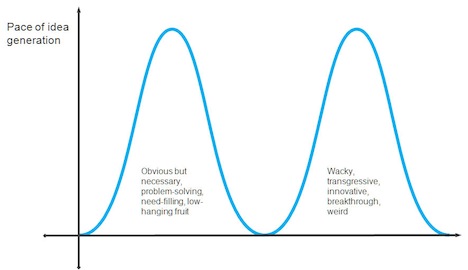Last Friday, consultant and author Steve Portigal left behind the California sunshine to speak at the 18F headquarters. Steve — principal at Portigal Consulting, author, podcaster, and ramen aficionado — expounded on the topic of bad ideas: Namely, how they add value to the creative process and why we should seek them out.
We encourage you to watch the entirety of Steve’s presentation (including the Q&A), and you can view his Slideshare here. Of course, we also encourage you to read his book Interviewing Users: How To Uncover Compelling Insights, and check out his podcast (Dollars to Donuts podcast), too. For a quick recap of Friday’s event, read on.
Steve began by defining the bad idea as one that causes a visceral reaction: the gut-punch, stomach-drop feeling you get when you hear something so ridiculous you feel you must have heard wrong.
Definition established, Steve got right to the crux of his argument: The generation of bad ideas is necessary for the discovery of good ones. How can you harness the power of bad ideas to increase your team’s creative output? By keeping the following in mind:
Bad ideas pave the way for good ones
As Steve himself describes in a post he wrote for Core77:
“Creative activities often follow a double-hump model. At first you’ll hit all the obvious ideas. These aren’t a waste of time; sometimes the obvious ideas have been neglected and you can treat those as low-hanging fruit: obvious, easy to implement, incremental improvement. But you’ll find that you run out of steam with those ideas. Like the false ending in a ’80s rock song, don’t think this fadeout means it’s time to start applauding. There’s still more. Push on, and this is when you get to the transgressive, weird, crazy and sometimes innovative ideas. That’s the place you want to get to, where you are truly butting up against the edges of what’s allowable.”

A safe space is necessary for top-notch brainstorming
True creativity doesn’t happen — can’t happen — when people don’t have a safe space to express themselves. It’s OK to laugh at ideas, but it’s not OK to laugh at people, which can cause folks to become self-conscious and engage in self-censorship. Shutting people down decreases their probability of participating in a brainstorm, effectively closing off a channel of potential ideas.
Even the greats throw out stinkbomb ideas
In fact, lots of famous creatives rely on bad ideas to get them to their great ones. If you haven’t read the transcripts of Steven Spielberg and George Lucas spitballing the story that would become Raiders of the Lost Ark, do: It’s fascinating. And it will help you realize, as Lucas says, sometimes you need only go “one sentence further and it’s a great idea.”
Bad is judged by the marketplace
Bad ideas are great during the ideation process, but can be harmful if they make their way into the world. One powerful example: The Homeless Hotspots created for SxSW in 2012. What was conceived as a charitable experiment drew flak for its creators’ apparent lack of cultural awareness. A similar idea for mobile battery-charging stations, which were staffed by Craigslist-sourced contractors, drew far less criticism. Though both promotions offered similar services and both came from a place of good intent, one hit on complex convictions about the employment and marginalization of different populations. Before implementing an idea, always consider the context into which you’re introducing it and the cultural implications your idea may carry.
Bad helps us define the criteria for good
Being confronted by shockingly bad ideas — those that stand in decided opposition to established social norms — can actually help us refine and concretize our definition of bad. Encountering a truly terrible idea gives us the chance to discuss why that idea is terrible and develop shared evaluative principles — a common vocabulary for what’s good.
Many thanks to Steve for coming to talk to us, and thanks to all who attended and participated in the Q&A.
Our next speaker, Knight-Mozilla Fellow Livia Labate, will be presenting in March — stay tuned for more details!

